 Just last month, Z-Man Games released the latest title in the Pandemic line, Pandemic: Contagion. This time, however, you’re not trying to eradicate infectious diseases. You are the diseases, working to wipe out as much of the world’s population as possible. With Ebola and Enterovirus constantly in the news, you’d think we’re on the verge of being wiped out by infectious diseases. As it turns out, that’s not as easy as the media makes it out to be—at least in this game.
Just last month, Z-Man Games released the latest title in the Pandemic line, Pandemic: Contagion. This time, however, you’re not trying to eradicate infectious diseases. You are the diseases, working to wipe out as much of the world’s population as possible. With Ebola and Enterovirus constantly in the news, you’d think we’re on the verge of being wiped out by infectious diseases. As it turns out, that’s not as easy as the media makes it out to be—at least in this game.
At a glance: Pandemic: Contagion is for 2 to 5 players, ages 13 and up, and takes about 30 minutes to play. It retails for $29.99. I would say the game mechanics are simple enough to pick up that you could probably drop that age to 10 or an experienced 8, with the caveat that you may need to explain why you’d want to be a deadly disease.
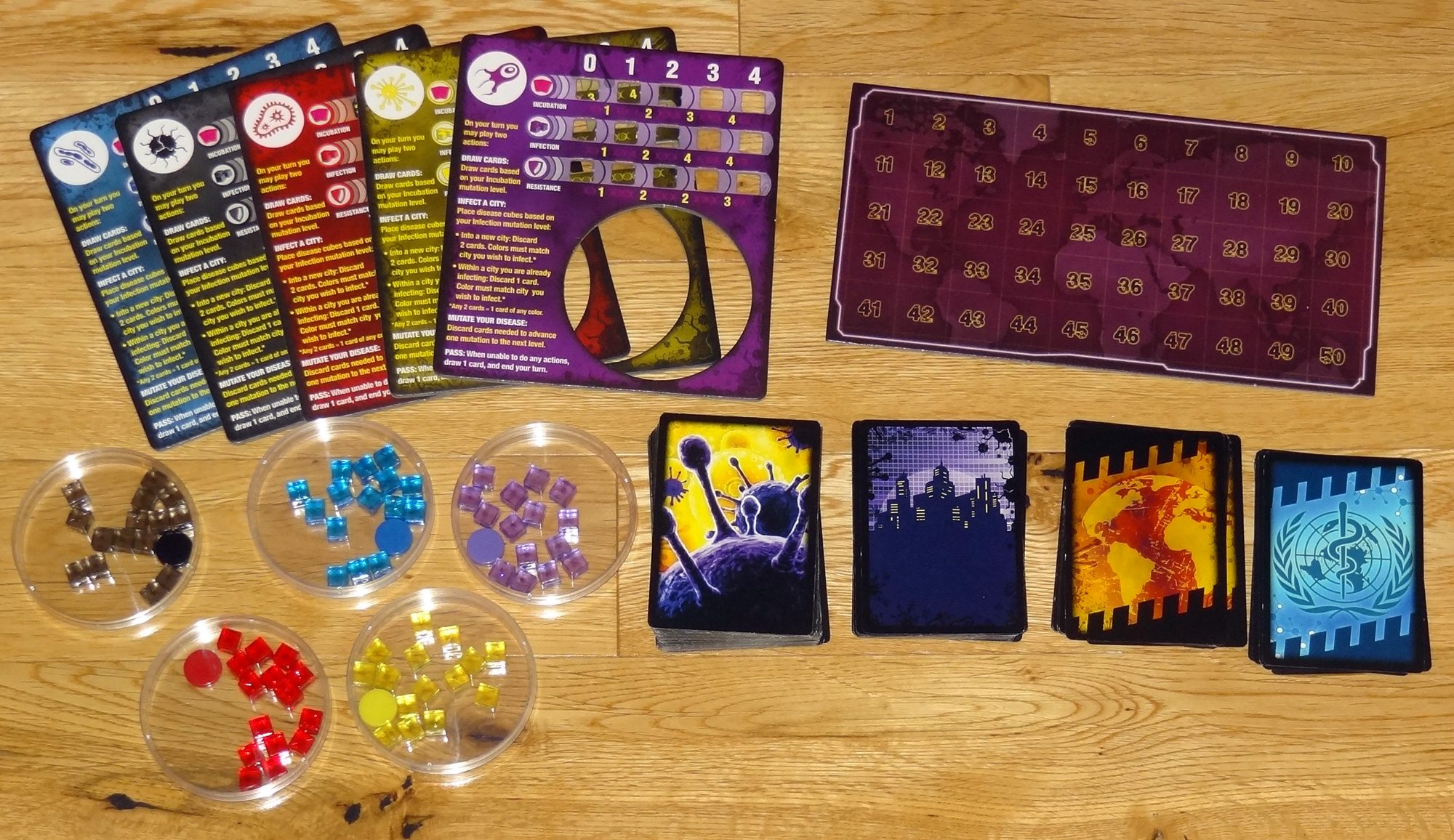
Components:
- 60 Contagion cards
- 24 City cards
- 12 Event cards
- 6 WHO cards
- 5 Player Disease boards
- 5 Score markers
- 5 Petri Dishes
- 75 Player Disease cubes (15 per player)
- 1 score board
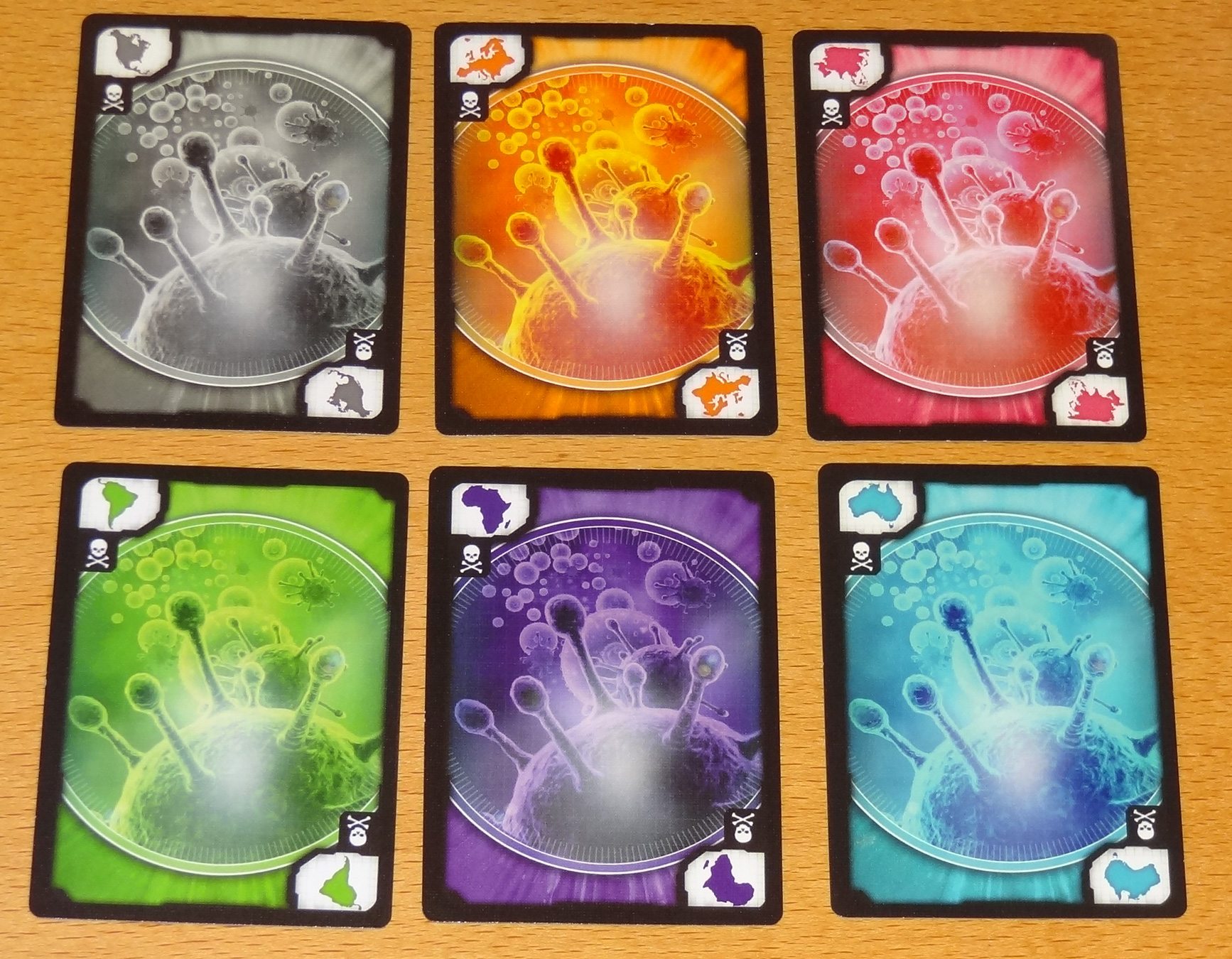
The Contagion cards are simply color-coded to apply to different regions. Each card has a color and the associated region in the corner. City cards have the name of the city, plus several numbers in the corner, a few rows for placing disease cubes, and finally a special effect at the bottom. The Events and WHO cards introduce random elements that may help or harm you throughout the game. I will note that the cards are decent quality, but because they have black borders, they’re already showing a little wear after a few plays.

The player boards are pretty nice: there’s a tracker for each of your three traits (Incubation, Infection, and Resistance), a turn summary printed on the side, and a large hole for the petri dish. The trackers have square holes punched out so that your tracking cubes slot into them rather than just sitting on top. I’m sure the game could have been smaller (and cheaper) without the punch-outs and the plastic petri dishes, but it’s fun and adds to the theme. And it’s nice that your cubes don’t slide around on the trackers.
The disease cubes are small translucent plastic cubes, and they look pretty nice. Next to them, the scoring tokens (opaque plastic disks) seem boring. The scoring track is just a simple piece of cardboard with squares from 1 to 50—nothing particularly exciting there.
As a bonus (to me, anyway), the box isn’t huge. There isn’t a box divider but everything just fits into the box without a bunch of empty space.
How to play
The rulebook is available as a PDF here.
The goal of the game is to have the most points at the end of the game by infecting and wiping out cities and mutating your disease.
To begin, each player takes a player board, petri dish, and the disease cubes of their color. Three cubes are placed on the player board marking the “1” level for each of the three traits. The Contagion deck is shuffled and each player is dealt four cards. The City deck is shuffled and a certain number of cities are laid out, depending on the number of players. The Event deck is set up: 3 Events, 1 WHO, 3 Events, 1 WHO, 3 Events, 1 WHO. Finally, each player will get to place one disease cube in a city of their choice.
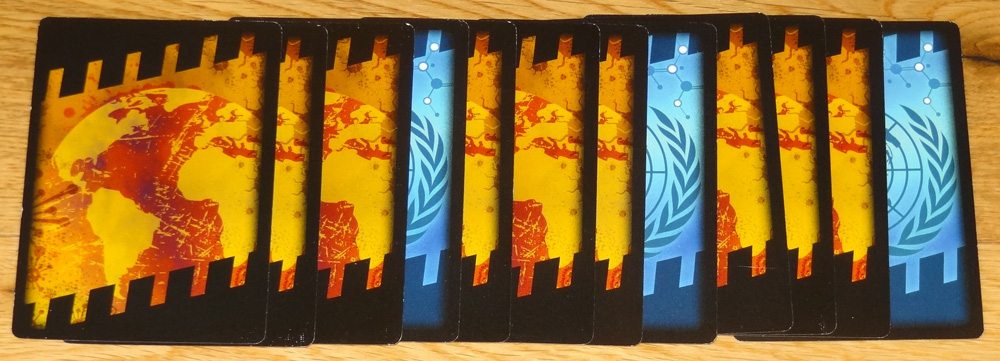
At the start of each round, the top card of the event deck is revealed—it will affect all players during their turn. Whenever a City icon appears on the Event card, you draw another City and add it to the table. Every two Skull icons, you do a “Death Toll” scoring of all infected cities.
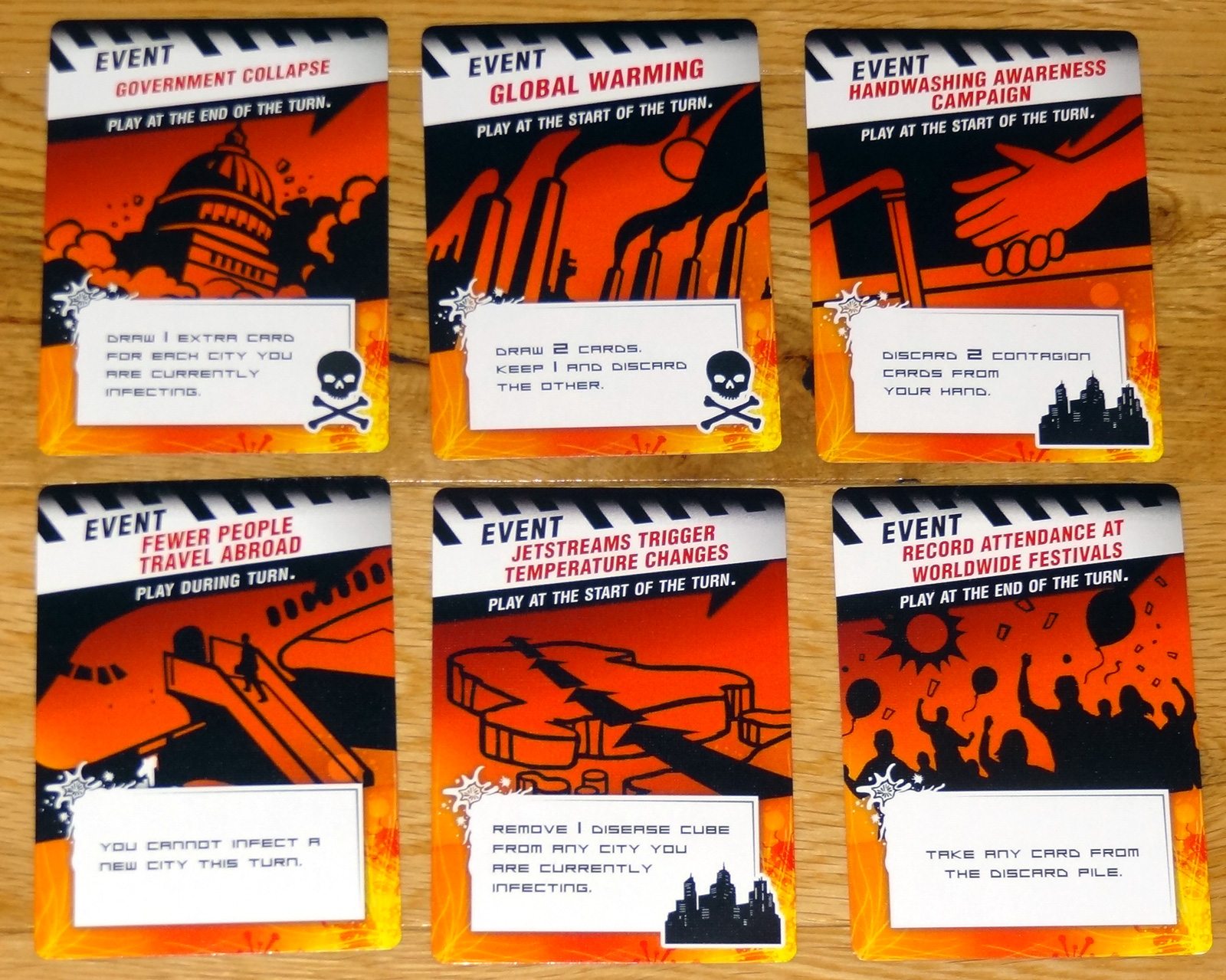
On your turn, you get to take two actions from the following (you may repeat an action): Incubate, Infect, or Mutate.
Incubate: Draw cards equal to your Incubation level.
Infect: Place cubes equal to your incubation level in any city. To infect a new city, you’ll need two cards of that city’s color. To infect a city you’re already in, you only need one card of that color. Any two cards may be played as a wild, counting as any color.
Mutate: Increase any of your trait levels by discarding the number of cards indicated on the track. Note that the number of cards doesn’t always correspond to the trait level. Increasing your Infection rate from 2 to 3 costs four cards, but increasing your Resistance level from 2 to 3 only costs 2 cards.
Your Resistance level helps protect you from various effects—any time you have to remove a cube from a city, lower a mutation level, or discard cards, you may lower your Resistance level to prevent that many elements from being lost.
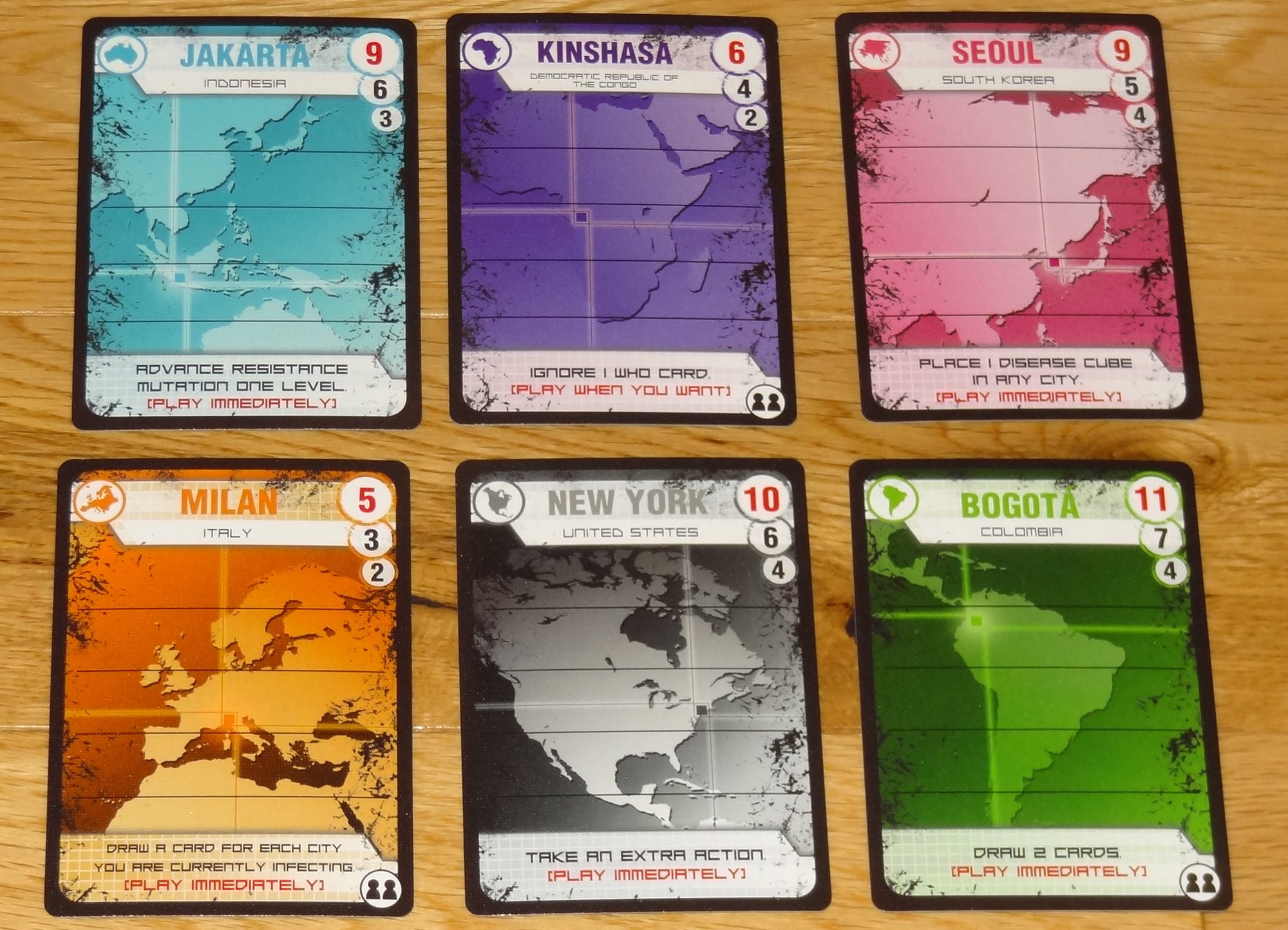
When you score infected cities for the Death Toll scoring, the player with the most cubes on the city gets the lowest number on the card, and nobody else scores. In case of a tie, whoever was first to infect that city gets the points.
The highest number on a City card (in red) represents that city’s population. If the number of disease cubes equals the population, you have wiped out that city. No more cubes are added, and instead there is an immediate eradication scoring. The player with the most cubes gets the highest number, second-most gets the second highest number, and third-most gets the third number. Again, in case of ties, the player who infected first wins.
Then, whichever player triggered the eradication (even if they weren’t first place) gets the City card. Some City cards have “play immediately” effects, and some may be saved and played at a later time.
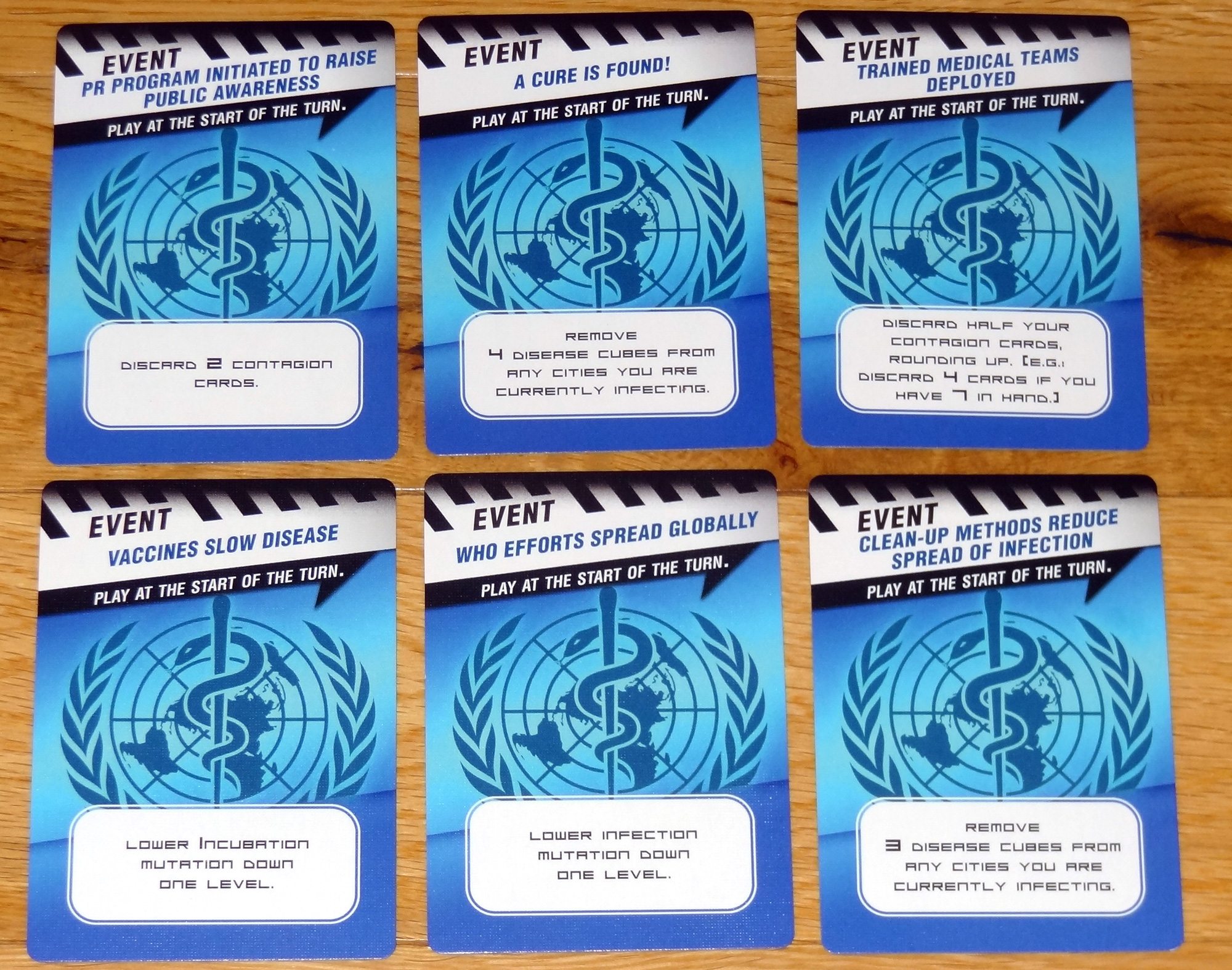
When the last WHO card is revealed or when there are only two cities remaining on the table, finish the round and then the game ends. At the end of the game, complete one more Death Toll scoring for any remaining infected cities. Then, add the total of your mutation levels to your score. Highest score wins, with ties going to the player with most mutations.
The two-player game is slightly different, with a dummy third player also adding cubes to cities.
The Verdict
I can’t quite decide if the release of a game about being a deadly disease during the Ebola crisis is great timing or terrible timing. Probably good timing for Z-Man Games, because it’s a topic that is on everyone’s mind. And, let’s face it, boardgamers don’t tend to shy away from difficult subjects in their games, right?
Although Pandemic: Contagion shares its title and branding with Pandemic, the game is a stand-alone and functions completely independently. It was designed by Carey Grayson. You may recognize the disease colors and the various cities that appear in the game, but otherwise there’s little overlap aside from the theme.
The game itself is pretty straightforward, with only three types of actions to choose from. You’ll have to decide how best to use your two actions: should you infect cities so that you’ll be in position when the next Death Toll scoring occurs? Or should you increase your incubation and infection levels so you can draw more cards and place more cubes at a time? Some of it will depend on whether the cards you draw happen to match the cities that are currently on the table, but you also need to make the best of the events as they occur.
I did try the two-player variant but didn’t find it quite as interesting, though some of that may have been because of the particular assortment of events and cities we drew. We had mostly low-population cities, and no Event cards that added more cities, so we ended up wiping out several cities quickly and the game ended well before the 12 round maximum. But I’m also not generally a fan of the dummy-player variants, and I’d much rather play with more real players.
One other downside to the game is that sometimes you’ll feel like you don’t have much choice. Certainly if you have no cards then you’ll have to take a draw cards action, and depending on whether you’ve increased your Incubation level, you may just have to draw cards twice. In some cases, players said that there seemed to be only one course of action that made sense on a given turn.
That said, Pandemic: Contagion does have an interesting feel to it, and success is based on a mixture of luck and adaptability. I also like that it’s an interesting way to model disease and how it spreads; the Events and WHO cards are like a mini-class in public health. Handwashing campaign? Darn. Bird migration season? Excellent.
If you don’t mind the morbid subject matter, Pandemic: Contagion is a fun way to play the flipside of Pandemic. It’s a much lighter game than its big brother, but it’s a pretty good short game that could follow up a round of battling diseases across the globe.
Pandemic: Contagion was released on October 20 and is in stores now.
Disclosure: GeekDad received a review copy of this game.
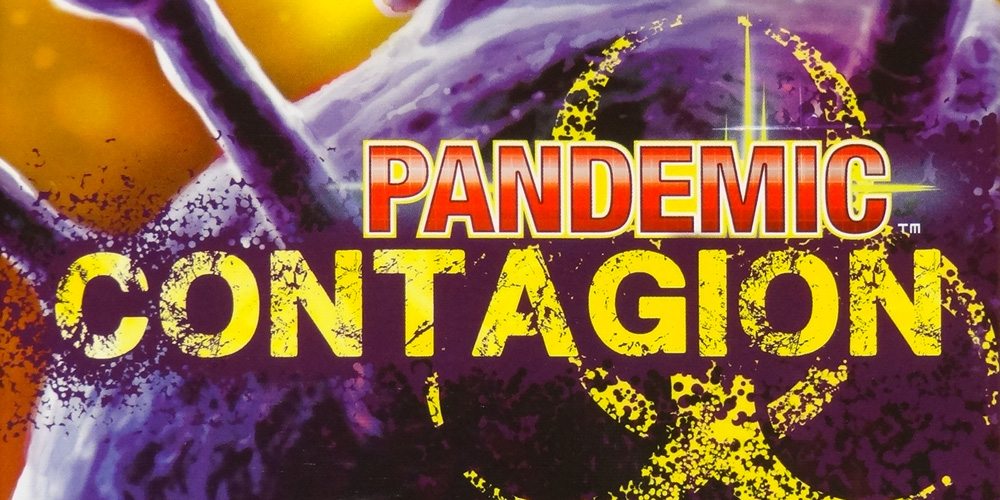




I don’t know. From a purely thematic point of view…I think I’d have to play this game first in the evening and then move on to Pandemic. The idea of a hard earned victory by the skin of our teeth, followed by actively *trying* to spread disease, might go against the grain a bit 😉